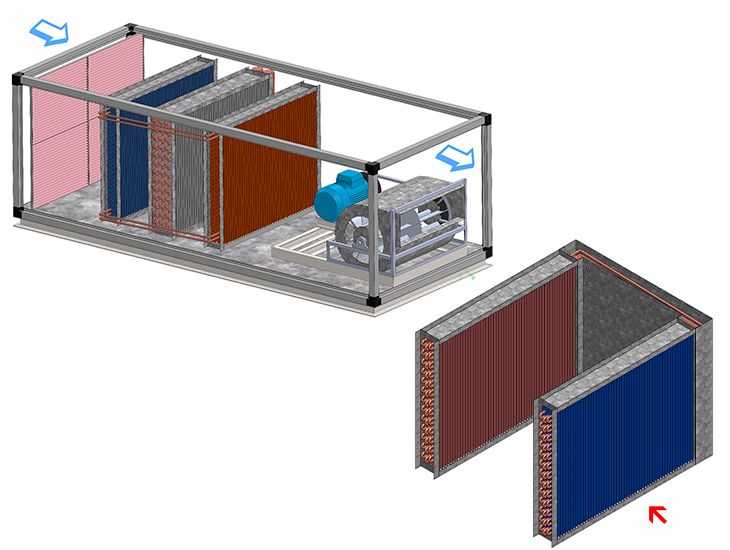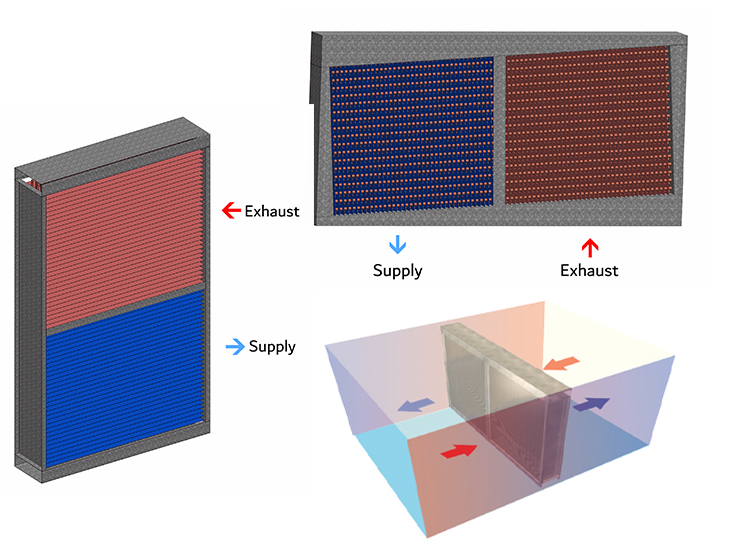Heat pipes is a heat-transfer passive device that employs phase transition from one location to another within closed-loop systems. They are used as heat recovery system.
Heat Pipe transmits heat using capillary & gravity action and the laws of thermodynamics. It is made up of a working fluid within an evacuated tube. The tube’s material is of high thermal conductivity, moving working refrigerant from the cold end (condensation) to the hot end (evaporation) of the heat pipe. The refrigerant within a heat pipe needs to have a low boiling point and a high latent heat of vaporization.
Heat Pipe circuits comprise multiple tubes connected in series, end-to-end for enhance performance.

ABOUT ENERGY RECOVERY HEAT PIPE
- Heat is absorbed by Incoming Hot Air from Liquid Refrigerant in the evaporating section. (Pre-Cool)
- Fluid boils to vapour phase. This increases the vapor pressure of the fluid and makes it to move rapidly to the cooler condenser section of the heat pipe, carrying along the absorbed heat.
- Heat is released by Leaving Cold Air to Vapour Refrigerant in upper part of cylinder, vapour condenses to liquid phase. (Re-Heat)
- Liquid returns by gravity to the lower part of cylinder (evaporating section) to complete the cycle.
- No external pumping force is required. (i.e. Passive)
HEAT PIPE FEATURES & BENEFITS

ENERGY RECOVERY
H & M energy recovery heat pipes can be used for comfort applications for process applications.
e.g. In Comfort cooling application during Summer, incoming fresh air is pre-cooled, and enthalpy is reduced before the fresh air enters the room or the air conditioning unit that further performs heat and moisture treatment. (AHU). This enhance Dehumidification for Humidity Control. Pre-conditioning the fresh air by above method reduces the heat load of HVAC systems and save the building energy costs.

NO CROSS CONTAMINATION
HVAC systems play a crucial role to maintain healthy and comfortable indoor air quality (IAQ) in almost all buildings. Research shows good IAQ substantially helps improve productivity in business, raise grades in schools, and minimize hazardous pathogens in the air.
Air by-passing the heat pipe or leakage between the two sides of the heat pipe will reduce performance and may also carry particles, odors, and condensate between the two sides.
H & M heat pipes are suitable for all applications, especially where cross contamination is not acceptable. Airstreams can be located with a horizontal and/or vertical separation to completely isolate hazardous exhaust to fresh intake air.
Best practise design of the air handling unit must be made in such a way that there always will be a higher pressure on the supply side than on the exhaust side.

PASSIVE SYSTEM
Heat pipes contain no mechanical moving parts or the energy input to operate the heat pipes.
Temperature difference between the two air streams activates the heat pipes and causes them to exchange heat.
Heat pipe operation utilizes the working fluid phase change, from a liquid to a vapor and back again.

DESIGN OPTIONS
H & M offer heat pipes with variations in types, sizes, materials specification, fin pitch, circuiting and configurations to meet the customer requirement.

LOW MAINTENANCE
H & M heat pipes are low in maintenance, lower in operating costs and last a very long time.
Since the heat pipes have no moving parts no complex maintenance is needed. A periodic cleaning is sufficient.
H & M recommends Heat pipe surfaces must be kept clean on regular interval to maximize system performance & increase the life span of heat pipe.
Adding the Pre-Filters in both the supply and exhaust airstreams can reduce fouling, cleaning frequency hence trouble free operation.
HEAT PIPE TYPES
H & M have been supplying refrigerant based heat pipe based products for the last five years to the HVAC industry for heating, cooling & dehumidifying of indoor environment. Our diverse product portfolio on heat pipes maximizes our ability to meet our customers’ application, performance, cost, reliability and project schedule requirements.
Our diverse product portfolio on heat pipes maximizes our ability to meet ourcustomers’ application, performance, cost, reliability and project schedule requirements.
Ideal applications are such as Treated Fresh Air Handling Unit withoutside air andareas withhigh-variable heat loads:
- Pharmaceutical
- Hospitals,Medical Laboratories
- Schools,Universities
- Government Facilities
- Convention Centres,Shopping Malls
- Hotels & Restaurant Facilities
- Commercial,Process Application
- DOASUnit(Dedicated Outside Air System)
- Clean Rooms,Data Centres
- Museums,Libraries

HEAT PIPE FEATURES & BENEFITS
H & M Wrap Around Heat Pipe system has two basic coils ie. a pre-cool coil and a re-heat coil that are inter-connected and placed around the air handling unit’s cooling coil (chilled water or DX).

- The first pre-cool coil, precools the entering air before it goes through the AHU cooling coil.
- The precooled air approaches the AHU cooling coil at a lower temperature, lowering the cooling load on the coil or force a lower dew point to increase the AHU coil ability to remove moisture (latent energy)
- The AHU cooling coil cools the air further before being reheated by the second re-heat coil, using the same heat originally absorbed by the first coil
- The reheated air from the re-heat coil reduce the energy cost by savings in resistive heating and provide required air temperature discharge to area.
Entire process of precool and reheat is accomplished with no additional energy due to the passive nature of the heat pipe. System ability to remove more moisture, control the humidity for better IAQ and energy savings.
Horizontal & Vertical Heat Pipe Heat Exchanger
- H & M Horizontal & Vertical Heat Pipe Heat Exchanger can be used in applications where there is a ducted exhaust air stream. Air that is exhausted from the building, is used to precool the incoming fresh air during summer to save energy.
- Intended for applications where two air streams are side by side (Horizontal) in a horizontal plane, or one air stream is right above the other (Vertical) with minimal distance between the air streams.
- Exhaust and supply can be of different lengths and air volumes with equal energy recovery.
- H & M heat pipes are economical because of their low initial cost and minimum maintenance requirement. The only maintenance required is periodic cleaning similar to any air conditioning coil. H & M heat pipes are reliable because they are passive with no moving parts.
- Partitions to separate the two air streams are an integral part of H & M energy recovery heat pipes.
- Energy recovery heat pipes from H & Mcompact design and take up much less space than other energy recovery schemes.

MATERIAL SPECIFICATIONS
H & Moffers energy recovery heat pipes in sizes customized for the particular application. H & M heat pipes are manufactured from high quality copper tubes for durability with high thermal performance.
| Standard specifications includes : | |
|---|---|
| Refrigerant | R-134a |
| Air Flow Range | 500 ~ 50,000 CFM |
| Fin Length & Fin Height | To suit customer requirement, AHU OEM coil size |
| No. of Rows Deep | 1 ~ 8 RD |
| Tube Geometry | 32 x 28 mm (1 1/4” x 1 1/8”) |
| Copper Tube Dia | ½” |
| Copper Tube Type | Inner Groove |
| Copper Tube Thk. | 0.32 mm base thickness |
| Standard specifications includes : | |
|---|---|
| Fin Material | Aluminium |
| Aluminium Fin Thk. | 0.12 mm |
| Fin Type | Sine wave with rippled edges |
| Fin Pitch | 8 FPI ~ 14 FPI |
| Coating | Pre-Coated hydrophobic blue fins |
| Casing | 1.2 mm ~ 1.6 mm Plain galvanized sheet steel |
| Charging Port | Brass Schrader valve in each circuit 7/16" – 20 UNF |
| Pressure Testing | 34 Bar (500 Psig) |
| H&M heat pipes can also be offered with following optional specifications : | |
|---|---|
| Copper Tube Thk. | 0.34, 0.48mm mm base thickness |
| Fin Type | Louvered |
| Aluminium Fin Thk | 0.14 mm, 0.15 mm |
| Casting | GSS Painted, Stainless Steel SS 304, SS 316 |
| Corrosion Protective Coating | Nano Coating, Heresite Coating |
